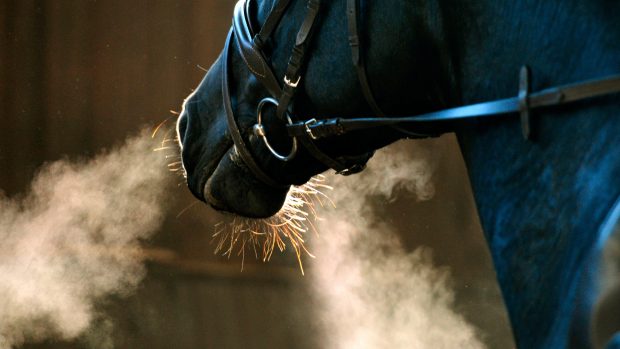If the real thing is too expensive (we hear you), a hobbyhorse might be the next best thing to a living, breathing horse. It’s essentially a toy, constructed of a stuffed fabric horse’s head attached to a stick. It might even have reins and a bridle, but it’s hardly going to take you to the Olympics – or is it?
Hobbyhorses have been around for donkeys’ years, if that’s not overdoing the mix of equid metaphors. Back in the 1500s they featured in German and Spanish artwork, 18th century Anglo-Irish literature and on to playing a part in folk traditions today, such as May Day celebrations and Morris dancing. However, it’s only been the past decade that the sport of “hobbyhorsing” has really taken off, although in Finland the trend has been quietly growing since the 19th century.

Hobbyhorses are a timeless passion, but the competitive sport has blossomed in the past five years
As an ideal present for pony-mad children, it’s unsurprising that hobbyhorses have become a huge craze among prepubescent girls – and older. “Riders” care for, groom and ride these imaginary horses, giving them names, breeds, and genders. There are not only riders, but coaches and judges. They compete in dressage and showjumping, they gallop, attend camps, and debrief afterwards about tactics and temperaments. It’s become such a hit in Finland that it has spread to other Nordic countries, Russia, France, Ukraine and the Netherlands, who all have hobby horse associations.
In fact, it’s not particularly new – it’s not a direct by-product of the global cost of living crisis forcing former pony owners to get their kicks in a fantasy world. The Finnish Hobbyhorse Association was founded in 2004, but really got going in 2016. In 2017, Finnish hobbyhorsing featured in a film, Hobbyhorse Revolution, which documented the often secret world of the hobbyhorse community. Not all practitioners go public with what some view as a rather obscure passion.
The association says: “There are two stereotypes about hobbyhorsists; we are either a bunch of school kids playing or a group of middle-aged women gone wild and jumping around the bushes.” The truth is that most are 12- to 18-year-old girls, but there are “plenty of adults in the community, most of them in their twenties started when they were young and just never stopped. Everyone can do it everywhere, so give your child a horse and let them play!”
There is an element of the centaur about the sport – with the lower half of the human’s body acting out the horse’s legs, the upper half the rider. Or perhaps just a different kind of ballet – you have a routine, you dance around on a stick, judges award marks… Either way, it’s fantasy, fun and some sort of escape from the humdrum of life for those who are hooked – much like the living, breathing version!

Hobbyhorsing holds an allure for all age groups, not just kids
The biggest hobbyhorsing championships in the world
Finland remains the go-to country for hobbyhorse enthusiasts, where there are more than 10,000 practitioners. Every year there is a hobbyhorse championship, held in the city of Seinäjoki organised by the Equestrian Federation of Finland, which draws in hundreds of competitors and thousands of spectators.
The championships first took place in 2012. The event features the Finnish national jumping classes, which go up to 1.10m max with timing, and you need to qualify to compete in the final. Some indication of Finland’s dominance is that the international showjumping class goes up to just 80cm. These classes may include either style evaluation or timing. And there’s also clear-round jumping and some sort of puissance (starts at 1.10m) – the only obstacle which can be approached “running” rather than in “canter or gallop”. The record is 4ft 7in.
Dressage-wise, there’s a grand prix and a kür as well as an “easy” and “advanced” class; there’s barrel racing for Western fans.
Competitive hobbyhorses are often hand-made by their owners, and there is a specific exhibition class for this at the championships. Interestingly, just mares and stallions can compete – no geldings allowed.

Competitive hobbyhorsing involves dressage and showjumping, and participants often compete horses they have made themselves
How to make a hobbyhorse
As well as riding and competing, hobbyhorsists enjoy what we might call the “stable management” and the business side (although all in good community spirit). Part of the fun is making horses as realistic as possible, selling, collecting and trading them, organising competitions and so on. If you’re not feeling too creative, check out readymade hobbyhorses at etsy.com or amazon.co.uk.
You can make your hobbyhorse using a sock, an old broom stick and a bit of creativity, but if you want to get stuck in to producing something a little special, you will need:
- a stick – or you can use a broom handle
- fabric the colour and texture of your choosing
- black fabric for the nostrils
- craft eyes
- wool yarn – for the mane and forelock in the colour of your choosing
- stuffing or filling
- pins
- marker pen
- paper or card for the pattern
- glue gun (not essential)
Method:
- Make a pattern of a horse’s head without ears on paper or card, and cut it out
- Then pin this paper pattern on to the reverse of your chosen fabric. Use a marker pen to draw around the pattern
- Unpin, then turn the paper pattern over and repin to another part of your fabric (also reverse side) and mark again
- Sew the two horse heads together (reverse sides outermost) ideally with a sewing machine, leaving a gap at the bottom of the neck
- Turn the horse’s head out so that the stitching is on the inside
- Stuff the horse’s head and pin at the bottom to stop the filling coming out. Ideally the filling should not be too slippery because this can give a lumpy result
- Now for the ears. Cut two pieces of paper that are the same shape as a horse’s ear as viewed from the front, and then repeat so you have two pairs. Sew the sides together and attach to the top of the head
- Craft eyes can either be fixed in, hot-glued or sewn on
- For the mane: decide on the length you want the mane to be, say 10cm, then double that length, to 20cm. Holding that 20cm length in your hand, pull out another 20cm length and loop it back, and keep repeating so you have a big bundle of looped yarn at 20cm. Trim all the ends of the loops off, and group the threads into bunches of four and tie through the middle (so at 10cm) with a double knot. Either using a glue-gun or sewing, attach the bunches to the neck of the horse, and a few at the front for the forelock
- For the hose you can stick on black fabric cut out in the shape of nostrils
- Push the stick deep into the stuffing at the bottom of the neck and tape it on firmly
- Now all you have to do is to give your new horse a name and create a background – breeding, temperament, ability.
Where can I compete hobbyhorses?
Have you got the bug? The first lockdown provoked a wave of hobbyhorse competitions in this country, many to raise funds for the NHS. While it’s nothing like the scale of the Nordic trend, it’s worth looking out for some local classes, or sideshows at some bigger rural events to occupy the children. By and large, once equestrian competition resumed later in 2020, the hobbyhorses largely went back on to (toy) box rest.
But there’s still an appetite for hobbyhorsing at a fun level. For instance, at Hurst Show and Country Fayre, Berks, on 26 June 2022, the team are hoping to break the Guinness World for the “largest stick horse parade” with a 1km hack around the village.
Certain Pony Club branches occasionally run hobby horse competitions, but in this country at least, hobbyhorse competitions are probably more likely to be seen as a bit of fun at a school sports day than as a serious competition.
In Britain, the hobbyhorse vogue is more in the vein of celebrating famous horses’ achievements, such as 2011 Gold Cup winner Long Run and dressage star Valegro. Though who wouldn’t want to ride him in the dressage grand prix at the Seinäjoki hobbyhorse championships?

Start young, and one day you may make it to the hobbyhorsing championships
- Are you a keen hobbyhorse enthusiast? Let us know about your experiences via hhletters@futurenet.com
You may also like to read…
The Cheltenham Collection has added a 'Long Run' hobby horse to its 2011-12 range
The venue for the 2018 World Equestrian Games will be hosting an equine series with a difference this summer
Milldene Primary School in Tiptree, Essex put on an equestrian themed sports day following the British success at the Olympic
‘Valegro II, according to Carl Hester, has all the attributes to make a top international prospect’

Enjoy a ride on your very own Gold Cup winner

Horses, but not as we know them: hobbyhorse craze goes global
.jpg)
Olympics inspires an equestrian themed sports day

Valegro’s one-legged ‘full brother’ goes up for auction

Subscribe to Horse & Hound magazine today – and enjoy unlimited website access all year round
Horse & Hound magazine, out every Thursday, is packed with all the latest news and reports, as well as interviews, specials, nostalgia, vet and training advice. Find how you can enjoy the magazine delivered to your door every week, plus options to upgrade your subscription to access our online service that brings you breaking news and reports as well as other benefits.




